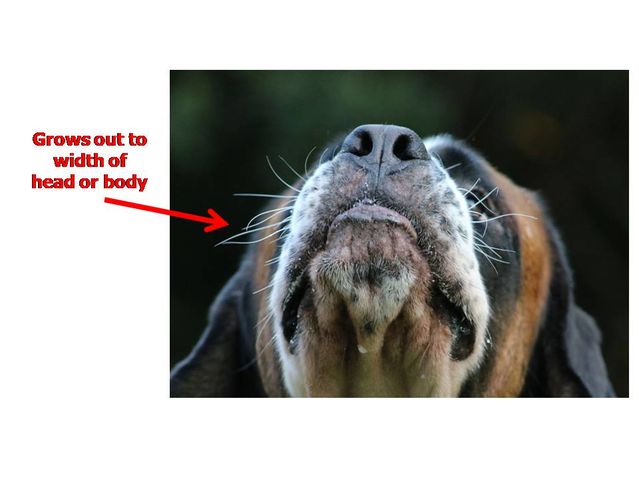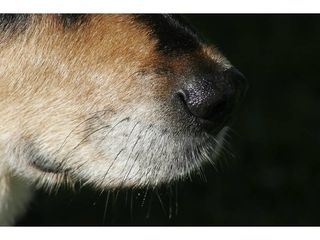
So the reason that dogs have whiskers is because despite their great senses of smell and hearing canine vision is not so wonderful. Like cats dogs will often reflexively flare their whiskers and then point them in a forward direction when they feel threatened which some scientists believe indicates that whiskers play a role in the defense strategy during combative.

Sometimes the bumps that whiskers grow from which are perfectly normal can be mistaken for acne spots.
Why does my dog have whiskers under his chin. The chin whiskers can pick up vibrations that your dog reads. If your dog perceives the information received through these vibrations as a threat he can use this information against the predator in defense. Chin whiskers also provide him with feedback about the location and movement of an opponent in the event of combat.
Your dogs whiskers under the chin also offer an additional perk. They are very sensitive to changes in the air currents. So those chin whiskers provide your dog with information about any nearby moving objects.
A dog can therefore determine an objects size shape and moving pace based on the air vibration the object produces as it travels. Like cats dogs will often reflexively flare their whiskers and then point them in a forward direction when they feel threatened which some scientists believe indicates that whiskers play a role in the defense strategy during combative. Why Do Dogs Have Whiskers Under The Chin.
By Adrienne Farricelli CPDT-KA. By Stanley Coren PhD for AKC Family Dog Dogs have a set of stiff hairs protruding from the sides of their muzzles that are popularly called whiskers These are not at all like the. So the reason that dogs have whiskers is because despite their great senses of smell and hearing canine vision is not so wonderful.
That little cluster of whiskers under his chin which often sprouts from a dark spot of skin is called the interramal tuft. Why Do Dogs Need Whiskers. Your dogs whiskers help him define distance and where he is in space to guide him through his daily interactions.
Up to 20 cash back My dog has a lump under his skin by his whiskers which is tender could this be an infected whisker follicle. And how do - Answered by a verified Dog Specialist. I have a 14 week old female boxer that has two bumps growing under her chin.
They seem to grow daily. She eats out of stainless steel bowl. The bumps are underneath her.
Salivary cysts are due to saliva leaking into the tissues surrounding the salivary glands causing a large firm swelling below the jaw of the dog. If your dog cannot locate a treat right under his nose it is either because the color does not stand out against the background or it has fallen on their blind spot. Thats when their chin whiskers come in action.
It helps them locate things right under their nose. Just as on a dogs muzzle the whiskers under a dogs chin are crucial for sensory information. Cutting or trimming these whiskers has the same impact on a dog as cutting or trimming other whiskers which is a reduced ability to navigate around.
Classic dog acne affects the dogs muzzle particularly the chin and lips. Mild acne looks like raised red bumps on the skin. Be sure to look closely.
Sometimes the bumps that whiskers grow from which are perfectly normal can be mistaken for acne spots. What Is a Pustule on a Dog. Whiskers among other things serve three distinct purposes.
As sensors that help identify close objects and help his spatial awareness as indicators of a dogs emotional state and as a means of protecting your poochs face. Whiskers Act as Sensors. Your dog may have environmental allergies such as to pollen or dust mites or to chemicals such as the detergent used when washing his bedding.
Your dog can develop sensitivities to the plastic of his food or water dishes or even to the food itself. Whiskers are thicker and bristlier than the normal hairs. With roots that are three times deeper whiskers are tactically positioned on the chin and above the eyes and the upper lips.
All the dog breeds have whiskers. The pattern and placement might differ. Unlike humans it is not necessary that a dog has to attain puberty to have whiskers.
Many cases of canine acne are thought to be triggered by trauma to the skin of the chin or muzzle. This trauma can cause hairs to break off near the skins surface leading to inflammation within the hair follicle and eventual rupture of the hair follicle. When the hair follicle ruptures its contents are released into the surrounding skin.
The good news is that if the acne is mild your dog will have little discomfort. More severe cases however may be painful or itchy to your pup and will warrant a trip to your vet for treatment. Acne usually pops up when the whiskers or hairs near your pups.